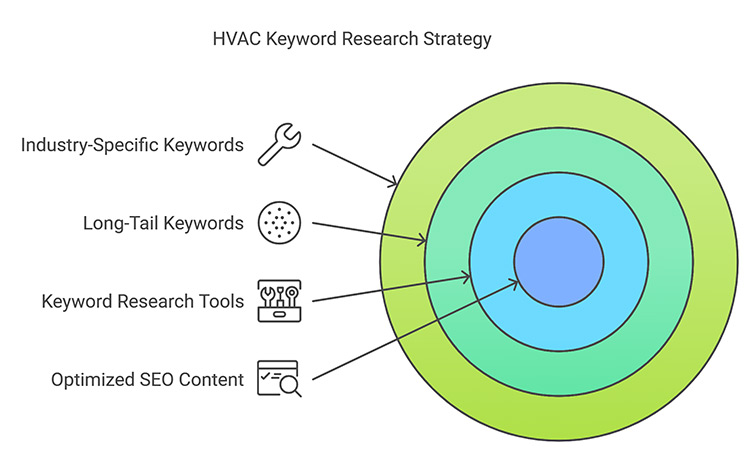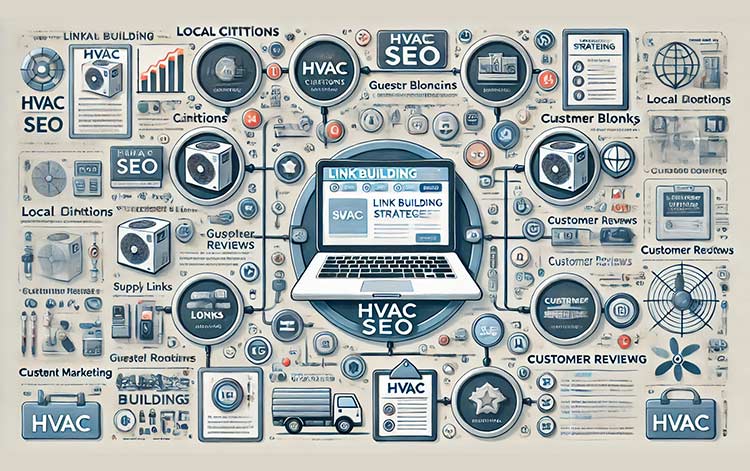In today’s digital landscape, where customers turn to search engines for almost every service need, Search Engine Optimization (SEO) has become a powerful tool for HVAC businesses looking to increase visibility, attract a local customer base, and establish authority within the industry. Gone are the days when word of mouth and a few business cards were enough to drive a steady stream of clients; now, businesses need to stand out online to stay competitive.
For HVAC companies, a strong SEO strategy means higher rankings on search engines like Google, making it easier for potential customers to find you precisely when they need your services. Implementing effective SEO doesn’t just boost traffic but helps draw in clients actively searching for HVAC services, positioning your company as a trusted solution in their time of need.
1. Understanding HVAC SEO
SEO, or Search Engine Optimization, is all about ensuring your website and online content rank higher in search engine results pages (SERPs). In the context of HVAC services, SEO involves tailoring your online presence to meet the specific needs of people looking for heating, ventilation, and air conditioning services. This means making sure your content answers the exact questions potential customers are asking and using terminology they’re searching for—whether it’s “air conditioner installation” in summer or “furnace repair” during colder months.
For HVAC businesses, SEO is more than just an online marketing strategy; it’s a way to ensure customers can find and choose your services among the sea of local competitors. With targeted SEO, HVAC companies can capture high-intent customers searching for specific services like “AC repair near me” or “energy-efficient HVAC systems,” which can lead directly to new clients and service appointments. SEO works to pull in these searchers and convert them from potential leads into loyal customers, often becoming their go-to provider for future needs.
2. Keyword Research Strategies for HVAC
At the core of any effective SEO plan lies thorough keyword research. This research forms the foundation of your SEO strategy, determining the specific terms and phrases that potential customers use when searching for HVAC services. Finding the right keywords allows you to optimize your content so that your website appears in relevant search results, increasing your chances of capturing new leads. Try our Local SEO Keyword Research Tool. This tool could help business owners generate keyword ideas by entering a keyword and location.
Steps for Finding Relevant HVAC Keywords
- Identify Industry-Specific Keywords: Start by brainstorming general HVAC terms that describe the services you offer, like “furnace repair,” “air conditioning installation,” and “HVAC maintenance.” These industry-specific keywords will serve as the main terms that customers use to search for the services you provide.
- Focus on Long-Tail Keywords for Niche Targeting: Long-tail keywords—such as “affordable HVAC repair services” or “best furnace repair in Toronto”—are more specific phrases that target a narrower audience. These keywords may have lower search volumes, but they often capture customers who are ready to book a service, as their search terms tend to be highly focused and intentional.
- Utilize Keyword Research Tools: To refine your keyword list, use tools like Google Keyword Planner, Ahrefs, or SEMrush. These platforms can provide data on search volume, competition, and keyword difficulty, allowing you to prioritize the most valuable terms.
Examples of Effective HVAC Keywords
To get you started, here are a few effective keywords commonly used in the HVAC industry:
- “Furnace repair”
- “HVAC installation”
- “Air conditioning maintenance”
- “Energy-efficient HVAC systems”
Selecting and strategically using these keywords in your content can significantly increase your visibility and help your HVAC business reach the right audience, positioning you as a top choice for their service needs.
3. On-Page SEO Optimization
On-page SEO is all about optimizing the elements within your website that impact search engine visibility, which ensures that your content speaks both to readers and search engines alike. For HVAC businesses, these optimizations can drive your website higher in search rankings, making it easier for potential clients to find your services when they need them. Here are some essential best practices for optimizing on-page SEO elements:
Crafting Title Tags and Meta Descriptions
Title tags and meta descriptions are the first pieces of information a searcher sees when your site appears in the results. They should be clear, compelling, and contain relevant keywords to encourage clicks. For instance, a title tag like “Expert Furnace Repair & HVAC Services in [Your City]” immediately communicates the service offered and the location, while the meta description can give a brief overview with a call to action.
Structuring Content with H1, H2, and H3 Tags
Using header tags (H1, H2, H3) to organize content not only makes your page more user-friendly but also helps search engines understand the hierarchy and relevance of your content. The H1 tag should be reserved for the main page title, while H2s and H3s can break down subtopics within the page. For example, an H2 might be “Our HVAC Services,” with H3s for “Furnace Repair” and “AC Installation.” This structure helps readers find information faster and makes the content more readable for search engines.
Natural Keyword Integration
Integrate keywords naturally throughout your content without overstuffing. Aim for a conversational tone where keywords flow seamlessly within sentences. This approach keeps readers engaged and improves readability while signaling relevance to search engines. For example, instead of repeating “HVAC repair” constantly, use variations like “heating and cooling repair” or “furnace maintenance” as appropriate to maintain natural language.
Image Optimization with Descriptive Alt Text
Images can enhance user experience but need to be optimized for SEO. Use descriptive file names and alt text for each image on your site to help search engines understand the image content. Alt text should accurately describe the image while incorporating keywords when relevant, such as “technician providing HVAC repair service in [City].” This not only aids with SEO but also improves accessibility for users with visual impairments.
4. Local SEO for HVAC Companies
For HVAC companies, which often rely on serving customers in specific geographic areas, local SEO is essential. Local SEO helps your business appear in search results when people nearby look for services you offer. Effective local SEO strategies can make your company a top choice for users searching for HVAC services in your area.
Setting Up and Optimizing Google My Business
Google My Business (GMB) is a free tool that enables businesses to manage their online presence on Google Maps and search results. By claiming and optimizing your GMB listing, you increase the chances of showing up in local searches and Google’s “Local Pack,” which appears above organic results. Ensure all information—business name, address, phone number, and hours of operation—is accurate. Adding high-quality photos, responding to reviews, and regularly updating posts can further improve visibility.
Using Location-Specific Keywords
Incorporate location-specific keywords throughout your content to target customers in specific areas. For example, use phrases like “furnace repair in [City]” or “HVAC installation near [Neighborhood]” to connect directly with local searchers. These keywords signal to search engines that your business serves a particular area, making it more likely to appear in relevant local searches.
Encouraging Customer Reviews
Customer reviews play a big role in local SEO and can influence potential clients’ decisions. Encourage satisfied customers to leave positive reviews on platforms like Google, Yelp, and industry-specific sites. Not only do these reviews boost credibility, but they also signal to search engines that your business is active and valued by local clients. Responding to reviews also demonstrates customer care and can improve your online reputation.
Creating Geo-Targeted Content
Geo-targeted content, such as blog posts or landing pages referencing specific locations, can help connect with local customers. For instance, creating content that references local landmarks, events, or neighborhoods shows search engines that your business is truly local. Examples include “How to Prepare Your HVAC System for [City’s] Winter” or “Energy-Efficient AC Options for Homes in [Neighborhood].” This type of content is particularly effective for attracting customers searching for HVAC solutions specific to their area.
5. Content Marketing for HVAC SEO
Content marketing is a powerful tool in SEO, helping HVAC businesses not only attract potential customers but also keep them engaged. By producing relevant, informative, and engaging content, you position your HVAC business as a helpful resource and industry expert. This trust-building approach can encourage visitors to return to your website, increasing the likelihood that they will choose your services when the need arises.
Types of Content to Consider
- Regular Blog Posts on HVAC Topics: Consistently publishing blog posts on HVAC topics relevant to your target audience can drive organic traffic to your site. For example, writing about “10 Common HVAC Problems and How to Prevent Them” or “How to Choose the Right AC System for Your Home” provides valuable information that attracts customers looking for answers and solutions. These posts also give you more opportunities to incorporate relevant keywords naturally.
- Educational Resources Like Guides and Infographics: Longer-form content, such as guides and infographics, can be valuable resources for potential customers. Creating a “Beginner’s Guide to Energy-Efficient HVAC Systems” or “Homeowner’s Guide to Furnace Maintenance” not only provides information but also positions your business as an authority in the HVAC field. Infographics, with their visual appeal, are highly shareable and can help you earn backlinks from other sites, which is beneficial for SEO.
- Videos Showcasing Expertise: Video content can significantly boost engagement and is ideal for demonstrating your expertise in a digestible format. Consider creating “how-to” videos for simple HVAC maintenance tips or showing a behind-the-scenes look at your work process. Videos can also be used to explain complex topics, such as “How a Furnace Works” or “What to Expect During an HVAC Installation.” This type of content is highly engaging and can boost your visibility on platforms like YouTube, which also serves as a powerful search engine.
- Solution-Focused Content for Common HVAC Issues: Addressing common HVAC problems that homeowners face can help you connect with clients actively seeking solutions. Posts or videos titled “Why Is My AC Blowing Warm Air?” or “How to Know When It’s Time for a Furnace Replacement” provide specific answers to common questions, making your content more relevant and valuable to potential clients. This approach can help drive targeted traffic to your site from searchers who are ready to act on the information.
6. Technical SEO Considerations
Technical SEO is the foundation of a well-optimized website, ensuring that search engines can effectively crawl, index, and rank your content. Without solid technical SEO, even the best content may struggle to reach its full potential in search results. Here are some essential technical SEO considerations for HVAC businesses:
Improving Website Loading Speed
Page loading speed is a crucial ranking factor for search engines and directly affects user experience. A slow website can drive potential customers away, while a fast-loading site keeps them engaged. To improve site speed, optimize image sizes, enable browser caching, and minimize JavaScript and CSS files. Tools like Google PageSpeed Insights can help you identify and resolve issues affecting loading time.
Ensuring Mobile-Friendly Design
With the majority of searches now conducted on mobile devices, having a mobile-friendly website is no longer optional. A responsive design that adapts to different screen sizes ensures that visitors have a positive experience on both mobile and desktop devices. Google’s Mobile-Friendly Test tool can help you determine how well your site performs on mobile and provide insights into necessary adjustments.
Using HTTPS for Security
Security is a key factor in SEO, especially since Google favors sites that use HTTPS over HTTP. HTTPS not only signals a secure browsing environment to users but also helps protect sensitive information, which is especially important if you have any forms on your site for service inquiries or bookings. Ensure your website has an SSL certificate, which activates HTTPS and indicates to both users and search engines that your site is safe.
Creating an XML Sitemap for Better Indexing
An XML sitemap is a file that lists all of the pages on your website, helping search engines understand the structure of your site and prioritize which pages to index. Submitting your sitemap to Google Search Console is a quick and effective way to improve your site’s crawlability. This simple addition can boost your chances of having all pages indexed, ensuring that potential customers have the opportunity to find all relevant information about your HVAC services.
7. Link Building Strategies
Building a strong portfolio of backlinks—links from other websites pointing to yours—is a crucial component of SEO. Backlinks act as endorsements for your site, showing search engines that other reputable sources find your content valuable. High-quality backlinks from trustworthy sites can boost your website’s authority and improve its ranking in search engine results, making it easier for potential clients to find your HVAC services.
Effective Link-Building Tactics
- Partnering with Local Businesses: Forming partnerships with other local businesses can be a win-win for link building. For instance, you could collaborate with real estate agencies, contractors, or home improvement stores to create referral agreements that include linking to each other’s websites. These partnerships not only build your link profile but also tap into your partners’ customer base, increasing local visibility.
- Guest Blogging for Industry Sites: Writing guest posts for HVAC or home improvement blogs can establish you as an industry expert while earning valuable backlinks. Look for reputable sites related to home services, energy efficiency, or property management. Craft informative articles that add value to their readers, and in return, you’ll gain a link back to your site, improving your credibility and search engine authority.
- Participating in Community Events and Sponsorships: Local events, sponsorships, or charity activities provide great link-building opportunities. When your business sponsors a local event or participates in community initiatives, organizations often mention sponsors on their websites. These backlinks are not only relevant to your area but also build goodwill with the community, improving brand reputation and visibility.
- Developing Shareable Content to Naturally Attract Links: Create content that others naturally want to share and reference, such as helpful guides, infographics, or insightful HVAC industry reports. When your content is informative, visually appealing, and unique, other sites are more likely to link to it as a reference. This approach attracts organic backlinks from people who find value in your resources, reinforcing your authority and visibility in the HVAC industry.
8. Tracking and Analyzing SEO Performance
To achieve long-term SEO success, it’s crucial to track your SEO efforts and make data-driven adjustments as needed. Regular monitoring allows you to understand what strategies are effective, which areas need improvement, and how to stay competitive.
Tools and Metrics to Track
- Google Analytics for Traffic and User Behavior: Google Analytics provides insights into how users interact with your website, showing details like where visitors come from, how long they stay, and which pages they engage with the most. Use this data to identify top-performing pages, spot drop-off points, and make improvements to increase conversions.
- SEO Tools for Keyword Ranking: Tools like Ahrefs, SEMrush, and Moz allow you to monitor how your target keywords perform in search results. Tracking keyword positions helps you see whether your content optimization is working and identify new keywords to target. Consistent improvements in rankings show that your SEO strategies are on the right track.
- Competitor Analysis: Regularly analyzing your competitors’ SEO strategies helps you stay competitive. Look at what keywords they rank for, the backlinks they’ve acquired, and the content topics they cover. This analysis can reveal opportunities for improvement and areas where you can differentiate your business.
- Regular Updates and Refinements in SEO Strategy: SEO is an evolving field, with search engines continuously updating their algorithms. Regularly reviewing your SEO strategy and adjusting based on performance data ensures that your efforts remain effective. Reevaluate your content, update outdated pages, and stay on top of new SEO trends and best practices to maintain a competitive edge.
Conclusion
SEO is a powerful tool for HVAC businesses looking to improve their online visibility, attract new customers, and build long-term authority in the industry. By implementing targeted strategies such as on-page and local SEO, keyword research, content marketing, technical SEO, link building, and performance tracking, HVAC companies can create a strong online presence that drives real business growth.
Investing in SEO is a continuous process, one that pays off over time as your website climbs higher in search results and attracts more qualified leads. For HVAC businesses looking to stay competitive, staying updated on SEO best practices and adapting to changes in the digital landscape are essential steps toward sustainable success.
If you’re ready to improve your HVAC business’s visibility and reach, start exploring these SEO strategies today, and watch as your customer base grows along with your online presence.
FAQs
SEO is essential for HVAC businesses because it improves your online visibility, helping potential customers find your services when they search online. Effective SEO strategies can drive more traffic to your website, build credibility, and ultimately increase sales by reaching people actively looking for HVAC solutions.
The best keywords for HVAC SEO often include specific services and locations, such as “furnace repair in [City]” or “AC installation near me.” Focusing on both broad terms like “HVAC repair” and long-tail keywords such as “energy-efficient HVAC system installation” can help you reach a targeted audience.
Local SEO is critical for HVAC businesses, as it helps you target customers within your service area. Optimizing for local search includes creating a Google My Business profile, encouraging reviews, and using location-specific keywords. This strategy helps your business show up in local search results, making it easier for nearby customers to find and choose you.
Content marketing, such as writing blog posts, creating guides, and producing videos, helps attract potential customers to your website by providing useful, informative resources. Content marketing builds trust with your audience and signals to search engines that your site is an authoritative source of HVAC information, which can improve your rankings over time.
SEO is a long-term strategy, and while some improvements can be seen within a few months, significant results may take six months to a year. Consistently monitoring and updating your SEO efforts is key to sustaining growth and maintaining high search rankings.





